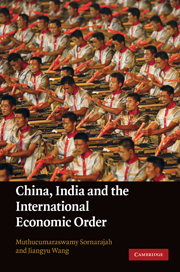Book contents
- Frontmatter
- Contents
- Notes on contributors
- Preface
- Introduction and overview
- PART I China, India and the global trade system
- PART II China, India and regional economic integration in Asia
- 10 The role of China and India in Asian regionalism
- 11 The Asian Economic Community
- 12 The China–ASEAN tariff acceleration clause
- 13 Financial cooperation and integration in East Asia
- PART III Law and development in China and India: Domestic issues
- Index
- References
11 - The Asian Economic Community
ASEAN – A building or a stumbling block for China and India economic cooperation
from PART II - China, India and regional economic integration in Asia
Published online by Cambridge University Press: 03 May 2011
- Frontmatter
- Contents
- Notes on contributors
- Preface
- Introduction and overview
- PART I China, India and the global trade system
- PART II China, India and regional economic integration in Asia
- 10 The role of China and India in Asian regionalism
- 11 The Asian Economic Community
- 12 The China–ASEAN tariff acceleration clause
- 13 Financial cooperation and integration in East Asia
- PART III Law and development in China and India: Domestic issues
- Index
- References
Summary
Introduction
The rise of China and India, two economic superpowers (if not quite yet military superpowers), almost simultaneously is perhaps unprecedented in history and this presents both opportunities and challenges. While the likelihood of actual military conflict has been somewhat limited by norms against the use of force since the Second World War, proxies for actual military conflict are often found as the trade skirmishes fought between the US, Japan and the EU have illustrated.
However, China and India have ostensibly chosen to pursue development strategies based on cooperation rather than competition. China has assured the Asian region that it will stay on the path of peaceful development and it is actively engaging other nations to work towards win-win partnerships. In particular, China has, along with Japan and South Korea, been working with ASEAN in the ASEAN+3 process. India has also embraced a policy that encourages regional cooperation. At the first East Asia Summit (EAS) held in Kuala Lumpur on 14 December 2005, the Indian Prime Minister, Manmohan Singh, outlined his vision of an emerging Asian Economic Community (AEC) as including ASEAN, India and China. He also envisioned a Pan Asian Free Trade Agreement which, together with many other free trade agreements (FTAs) being negotiated in the region, would form the building blocks of the eventual AEC. ASEAN is already in the process of negotiating FTAs with both China and India and has already concluded Framework Agreements (FAs) for these FTAs.
- Type
- Chapter
- Information
- China, India and the International Economic Order , pp. 387 - 426Publisher: Cambridge University PressPrint publication year: 2010



